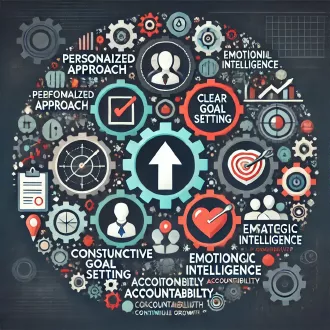Transcription Types of coaching models
The coaching process is based on a series of essential principles that establish the foundation for an environment of trust, respect and collaboration between coach and coachee.
These principles are the cornerstone that ensures the effectiveness and benefits of the personal and professional development process. By addressing these principles, we can understand how to create a space conducive to positive growth and transformation in the lives and leadership of individuals.
These principles are:
- Confidentiality: both coach and coachee commit to secrecy of conversations and information shared during the process. This discretion forms a foundation of safety, allowing the coachee to feel free to express themselves openly and honestly without fear of exposure.
- Mutual trust: building a trusting relationship between coach and coachee is vital to the success of the process. The coachee must trust that the coach is an ally committed to his or her growth and development, while the coach must trust the coachee's willingness to be actively involved and honest in their interactions.
- Respect and non-judgment: both aspects are intertwined in the coaching dynamic. The coach must practice an attitude of constant respect for the coachee, which implies listening without prejudice or value judgments. The coachee must feel that the coach is there to support and guide him/her, not to criticize or judge.
- Shared responsibility: the process is a collaboration in which both coach and coachee play active roles. While the coach offers guidance and tools, it is the coachee who takes responsibility for implementing actions and generating concrete changes in his or her life and leadership.
- Solution focus: as opposed to focusing on problems and obstacles, the coach and coachee work as a team to identify effective solutions and strategies for improvement. This positive and proactive approach contributes to the coachee's development and growth.
- The use of reflective questions: these questions guide the coachee toward a deeper understanding of his or her thoughts, emotions and goals. Through this exploration, the coachee can discover his or her own perspectives and find valuable answers for his or her development.
- The definition of measurable objectives: these objectives provide a clear direction for the process and allow progress to be evaluated over time. This ensures that the coaching process is concrete and oriented towards tangible results.
- The definition of an action plan: although coaching may explore past experiences, its primary focus is on the future and the achievement of goals. The coach and coachee collaborate to create an action plan that drives growth and development, charting a path to a more successful future.
- Empowerment: The coach provides the tools and support necessary for the coachee to make informed decisions, overcome challenges and achieve goals on his or her own. This empowerment allows the coachee to become an active agent in his or her own change and growth.
- Continuous improvement: an intrinsic principle of coaching, there is always room for improvement. Both coach and coachee are committed to a process of constant growth and continuous learning. This commitment extends beyond the coaching process, positively influencing the individual's life and leadership in the long term.
- Positive reinforcement: the coach must create energy by reinforcing improvement. Otherwise they will never reach the kind of performance they ultimately want to achieve.
types coaching




